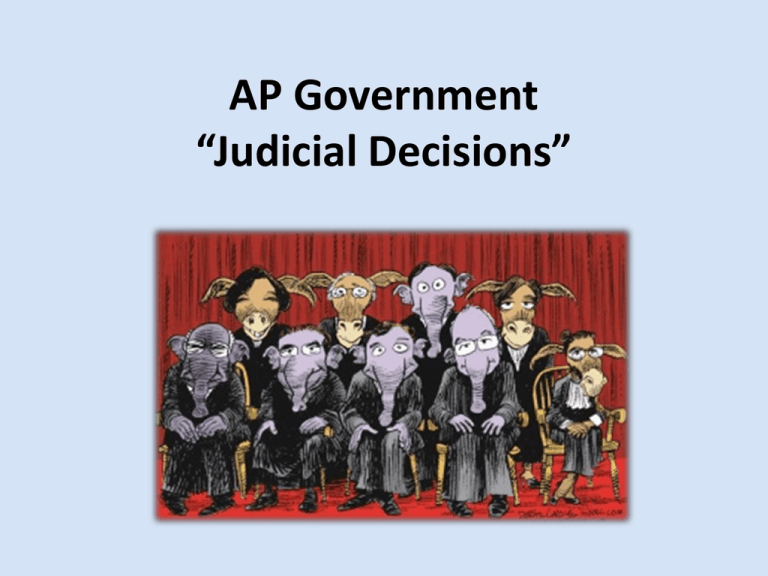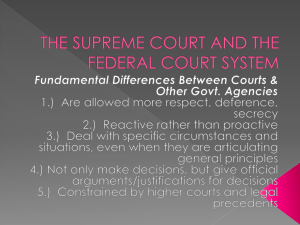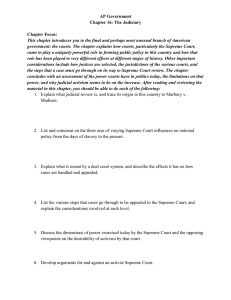File - Juarez AP GOV
advertisement

AP Government “Judicial Decisions” (1) Judicial Compensation • Justices in federal courts make salaries (in 2008) in excess of $155,000 and up to $217,000 • This is good money, but is not close the annual compensation they could make as an equity partner at a private law firm (over $1 million) Wisconsin Supreme Court Convenes (2) Selection of State Judges • In more than half the sates the governor appoints the state judges, often in consultation with judicial nominating commissions • In some states, nominations for judges must be confirmed by the state legislature • In other states judges are selected by partisan, nonpartisan, or legislative election • Wisconsin has supposedly nonpartisan elections of judges (see left) (3) Judicial Vacancies • Federal judge positions are for life (unless impeached) • They typically do not became vacant unless a federal judge retires or dies • Presidents must consider carefully the judges they appoint, as their decisions will typically affect the nation for a long time • As they are lifetime appointments, Presidents try to pick nominees who are sympathetic to their general views (4 & 5) Judicial Appointments • Senatorial courtesy – a norm under which a nomination for a federal court position (below the Supreme Court) must be acceptable to the home state senator from the President’s political party • The most important motivating force behind judicial appointments is ideology (the degree to which the nominees opinions and past legal decisions are conservative or liberal) (6) American Bar Association • American Bar Association – biggest organization of lawyers in the nation • The ABA has been involved in screening candidates for federal bench since 1946 • This is customary role, not one required by law • Getting a “well-qualified” rating by the ABA is an important factor in supporting a nominee (7) Diversity in Nominations • Which President since Jimmy Carter has the most federal court nominees in each of the following areas: – Women • Clinton – African Americans • Clinton on chart (Obama now) – Hispanics/Latinos • George W. Bush on chart (Obama now) – Most Liberal Judges • Carter (Obama not rated by text, but less likely to have more liberal judges due to partisan confirmation process) (8) Confirmation of Nominees • The President is not shackled by senatorial courtesy when filling positions on the Supreme Court • However, these nominations draw far more attention, which limits the President’s options, and requires Presidents to consider who will get approved by the Senate • The most important factor in the rejection of a nominee is partisan politics How can President Obama’s nominees get blocked if the Senate has had a Democratic majority? (9) Federal Cases • Only 10% of federal civil and criminal cases get to trial • Many civil suits are settle, or the parties give up, or the courts dismiss the suits as not resolvable • Many criminal cases end in a plea bargain with the defendant admitting guilt in exchange for a less severe punishment (10) Implementation of Decisions • Implementation of Supreme Court decisions depends on how they are worded • If they were ambiguous or vague, they will be harder to implement • Brown v. Board said integration of schools should take place “with all deliberate speed,” and yet many schools were still segregated years later • When controversial decisions are handed down, those who oppose the decision will drag their feet in carrying them out (11) Decisions and Public Opinion • Supreme Court decisions sometimes lag behind pubic opinion, but they rarely seem far out of line with it • This is due to 3 factors: – The Court has shown deference to national laws and policies which typically echo public opinion – The Court moves closer to public opinion during periods of crisis – Rulings that reflect the public view are subject to fewer changes than rulings that depart from public opinion (12) Class Action Suits • Class action suit – a procedure by which similarly situated litigants may be heard in a single lawsuit • These suits give legal power to individuals against more powerful opponents by pooling their resources • These suits have helped groups make claims involving civil rights, legislative apportionment, and environmental problems in ways single lawsuits could not (13) Reaching Decisions California Supreme Court • What state has the least number of state supreme court decisions followed by other states? • Where does Wisconsin rank in this category? • Judges reach decisions by paying attention to the views of other courts (not always above, but even below) • State Supreme Courts will look at the decisions of the Supreme Courts in other states, especially on issues that are new to them • California State Supreme Court decisions have been followed in other states’ decisions more than any other state • Likewise, US District Courts will look at the decisions of other US District Courts








